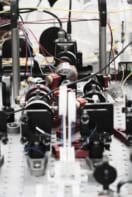
An interdisciplinary group of researchers is calling for the help of other scientists to help them to understand how some of the key features of human vision have evolved.
The team, led by Gasper Tkačik, a physicist at the University of Pennsylvania, has compiled a database of roughly 5000 images of the Okavango Delta region in Botswana. This tropical savannah habitat is believed to be similar to the conditions that existed in Africa around 20–30 million years ago, at the time of the origins of Old World monkeys, when the basic adaptations in our visual system are thought to have evolved.
The photos were taken by neuroscientist Lucia Seyfarth, one of Tkačik’s Pennsylvania colleagues, and they are meant to be similar to the views experienced by our remote ancestors as they went about their lives in this environment. Images include trees, the ground, bushes and they were taken, for instance, while she was following a baboon troop. Other images were designed to vary a range of parameters including the depth of shots and the time of day, and they have all been uploaded to a database hosted by the University of Pennsylvania.
A colourful mystery
Tkačik’s team is now encouraging researchers in related disciplines including physicists and neuroscientists to use the database as a resource for investigating different aspects of human vision. One of the key features of the human eye is its remarkable ability to distinguish between a vast array of colours thanks to cells at the back of the eye known as rod and cone photoreceptors. In terms of their function, rods are relatively well understood as being most effective in low lighting, providing us with a useful amount of night vision.
Cones, on the other hand, enable the eye to see the entire spectrum of colours under the full light of day. They come in three varieties called L, M and S, which detect the red, green and blue sections of the spectrum respectively. Scientists were initially puzzled by the distributions of cones as S cones account for just 10% and the ratio of L–M can vary dramatically between people. A study published last year, based on the Botswana database, suggests that these particular ratios are theoretically optimal for capturing as much colour information as possible from our visual environments.
“The database has been designed to enable scientists to investigate this and similar questions about the architecture of our retinas, and try to understand the particular anatomical findings as evolutionary adaptations to our environments,” Tkačik tells physicsworld.com. In addition to greyscale and raw RGB photos, the database also contains images that have been calibrated to show how incoming light hitting the camera sensor would have stimulated the different types of cone in the eye to varying extents.
“There are other image databases out there for this kind of research but ours is the first one to snap the region similar to where the humans evolved,” says Tkačik. “It is also novel because we are providing images not only in the raw units of light intensity, but also in the physiologically relevant units that measure how our cones respond to that incident light.”
Perfecting ‘machine vision’
In addition to aiding fundamental science, the database may also help computer scientists to develop more advanced artificial intelligence systems. Tkačik believes, for instance, that it could lead to more advanced “machine vision”. This is already used in photo and social networking websites to identify faces and certain objects within photos. He says it could also help to develop more realistic scenes and textures in computer simulations and video games where dynamic graphics need to be compressed while remaining faithful to what the eye sees in the real world.
To develop the project, the researchers hope to assemble similar collections of images acquired in different environments including cities and other urban settings. Comparing images from a range of different environments may help neuroscientists to investigate how information is both perceived and then processed by the visual cortex inside the brain. “In the city there are a lot of sharp lines to contend with but our visual systems seem to be able to deal with this just fine,” says Tkačik.
Tkačik, who is currently at Institute of Science and Technology Austria, would also like to start assembling a similar database containing video data, which could help neuroscientists to explain why the human visual system is well evolved to deal with changing scenes and processing motion.
This research was published on the arXiv preprint server.













